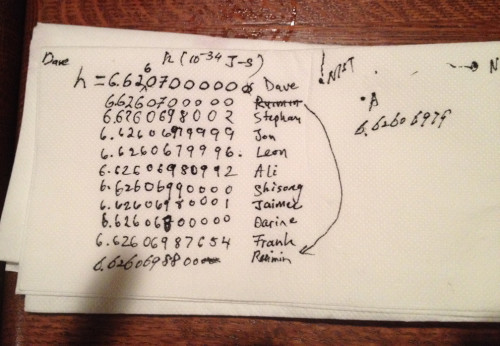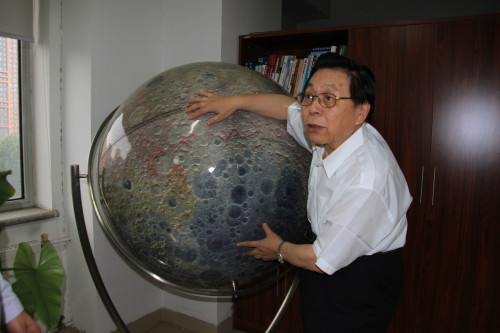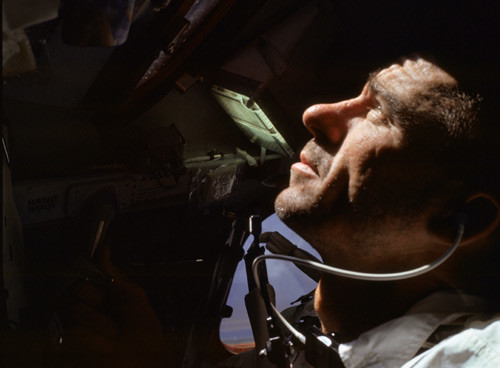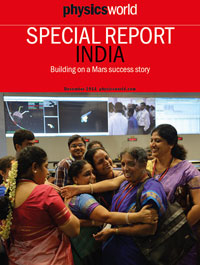Tag archives: Mars
A punt on Planck, physicist puts Frankenstein to music, would Brian Cox cope on Mars?

Fancy a flutter? The NIST napkin. (Courtesy: NIST)
By Hamish Johnston
A paper napkin with a load of numbers scrawled on top has been an unusual source of excitement for physicists at the US National Institute of Standards and Technology (NIST) in Gaithersburg, Maryland. One evening in December 2013, a group of them had gathered at a local watering hole to celebrate the success of NIST’s latest watt balance – NIST-3 – that had just determined Planck’s constant to a new accuracy. While enjoying “happy hour”, NIST researcher Dave Newell pulled out a napkin and the 10 researchers began to write down their predictions for the final value of Planck’s constant that NIST would submit to the International Bureau of Weights and Measures in Paris to help redefine the kilogram. The researchers then sealed the napkin in a plastic bottle and buried it inside a cavity within the foundation of NIST-3’s successor NIST-4, which was then being constructed.
View all posts by this author | View this author's profile
Happy birthday Curiosity, overpaid footballers, cheeky Einstein photo sells
By Sarah Tesh, Hamish Johnston and Michael Banks
It’s Mars Curiosity’s 5th birthday tomorrow! The NASA rover touched down on 5 August 2012 and has been exploring the red planet ever since. It has travelled more than 10 miles, studied more than 600 vertical feet of rock and even proved that Mars was once habitable. While a Mars birthday party for Curiosity would be a lonely affair, researchers at NASA Goddard Space Flight Center have programmed the rover to sing “Happy birthday” to itself using its Sample Analysis at Mars (SAM) instrument. To introduce ground samples into the rover, SAM resonates through a range of frequencies, so the researchers programmed the instrument to run through the frequencies of the celebratory song.
View all posts by this author | View this author's profile
Mars mission gains currency in India, nuclear obliteration and a super-duper moon

The Reserve Bank of India’s new Rs2000 banknote features the country’s first interplanetary spacecraft, Mangalyaan. (Courtesy: Ronnie Commissariat)
By Tushna Commissariat, James Dacey and Hamish Johnston
Nearly three years after it was successfully launched into orbit around Mars, India’s Mangalyaan orbiter has begun a new type of circulation – on a newly issued Indian banknote. Earlier this week, Indian prime minister Narendra Modi unexpectedly announced that the country’s ubiquitous Rs500 and Rs1000 notes would no longer be legal tender, effective immediately. New Rs500 and Rs2000 notes have instead be issued, the latter featuring the spacecraft.
View all posts by this author | View this author's profile
China’s chief Moon scientist Ziyuan Ouyang outlines lunar plans

The Moon man: Ziyuan Ouyang in his office at the National Astronomical Observatories with a lunar globe covered with images taken by Chinese craft. (Courtesy: Mingfang Lu)
By Matin Durrani in Beijing, China
I caught up this morning on the second day of my visit to Beijing with Ziyuan Ouyang, chief scientist of China’s Moon programme at the National Astronomical Observatories, which lies not far from the city’s iconic “bird’s-nest” Olympic stadium.
I’d first met Ouyang on my last visit in 2011 when the country had so far launched two lunar missions – Chang’e 1 (which orbited the Moon for 18 months before crash-landing onto the lunar surface) and Chang’e 2 (another lunar orbiter that later moved off into interplanetary space).
China’s lunar efforts have continued and Ouyang explained to me what has happened since my last visit – and what the country plans to do next.
View all posts by this author | View this author's profile
How to cook the perfect steak, Bill Nye gets tangled about entanglement and the challenges of going to Mars

The wrong way: where is the liquid nitrogen and duck fat? (CC BY 2.0 _BuBBy_)
By Hamish Johnston
How do you cook the perfect steak? Materials scientist Mark Miodownik of University College London has the answer. To cook his medium-rare steak (pink in the middle with a seared coating on the outside), Miodownik first seals the steak in a vacuum bag and places it in a warm water bath until it reaches 55 °C. He then dips it in liquid nitrogen for 30 s to chill the outer layer without freezing the middle. If that wasn’t unconventional enough, he then throws it into a deep-fat fryer containing duck fat. The result? “A lusciously seared steak, medium rare all the way through. And not a pan in sight!” says Miodownik. The BBC has put together a nice animation of the recipe: “What’s the weirdest way to cook a steak?”.
Soft hair on black holes, making concrete on Mars and exploring the cosmos in 2016
By Hamish Johnston
This week’s Red Folder looks to the cosmos, starting with a spiffy new video from the European Space Agency. The slick presentation is a preview of some of the extra-terrestrial exploits that the agency has planned for 2016. This includes the landing of the Schiaparelli probe on the surface of Mars. This stationery lander will survey its Martian environs to find a suitable location to drop the ExoMars rover in 2018. The mission’s namesake is the Italian astronomer Giovanni Schiaparelli, who mapped the surface of Mars and was the first to use the term canali to describe the straight lines that were thought to exist on the surface of the planet.
It’s possible that someday humans will colonize Mars and this will involve building dwellings and other structures on the Red Planet. In preparation, Lin Wan, Roman Wendner and Gianluca Cusatis at Northwestern University in the US have come up with a recipe for making concrete on Mars. The trio reckon that any successful colonization of the Red Planet will have to rely on local building materials because shipping stuff from Earth would be horrendously expensive.
Curiosity findings puzzle Mars rover team
By James Dacey in San Francisco
Rocks rich in silica have been discovered on the surface of Mars, bearing a resemblance to environments on Earth that support microbial life. It’s the latest finding from NASA’s Mars Curiosity rover, presented today in San Francisco at the annual meeting of the American Geophysical Union.
After landing in the Gale crater region of Mars in 2012, NASA’s car-sized rover spent the first couple of years exploring the planes around the elevated region known as Mount Sharp. Since 2014 the rover has started exploring the mountain itself, working its way up from the base.
View all posts by this author | View this author's profile
Pushing towards the human–Martian frontier

Eye on the sky: NASA astronaut Walter Cunningham during the Apollo 7 mission, in October 1968. (Courtesy: NASA)
By Tamela Maciel at the National Space Centre in Leicester
Last week, the planet Mars was under the international spotlight once more as NASA scientists announced that liquid water may still be flowing on the surface of the red planet. Also, the much-anticipated film adaptation of The Martian – a 2011 novel by American author Andy Weir – a science-driven story of human survival on Mars, hit the box office. Mars was also the hot topic at a recent event held at the National Space Centre in Leicester. The guest of honour was Apollo 7 astronaut Walter Cunningham and throughout the hour-long Q&A, he emphasized the need to push the “next frontier” and send humans to Mars.
Cunningham is not a man lacking in confidence or the experience of pushing boundaries. When asked if he ever felt the pressure of the astronaut selection or training process, he said “I thought I could fly anything, any time, anywhere. Was that true? I don’t know. But that’s how I felt.”
View all posts by this author | View this author's profile
Deflategate, DIY particle detection and an ode to Beagle 2
By Hamish Johnston
Loyal sports fans often need a reason for losing beyond “their team was better than ours”, and the latest blame-game in American football comes with a twist of physics to it. The run-up to this year’s Superbowl is no exception. Some disgruntled Indianapolis Colts fans claim that the New England Patriots had taken advantage of deflated footballs to make their decisive 45-7 victory on 18 January, which sends them to the championship game.
View all posts by this author | View this author's profile
Physics World Special Report: India
By Michael Banks

This year has been one of change for India. In May, some 800 million eligible voters went to the polls in an election that was won by the Bhartiya Janata Party. Led by Narendra Modi, the party went on to form a coalition government called the National Democratic Alliance.
Our Special Report, which you can read free online, kicks off by looking at how science is faring under Modi’s fledgling administration. Indeed, in September, Modi was personally on hand at the Indian Space Research Organisation (ISRO) to laud engineers who had just carefully manoeuvred the Mars Orbiter Mission into position around the red planet – a feat that announced India as a major player in space exploration.
Modi’s personal interest in ISRO will not only please the organization’s chairman K Radhakrishnan, who we interview for the report, but could also be seen as a sign that the new administration is serious about boosting science in the country.
View all posts by this author | View this author's profile
